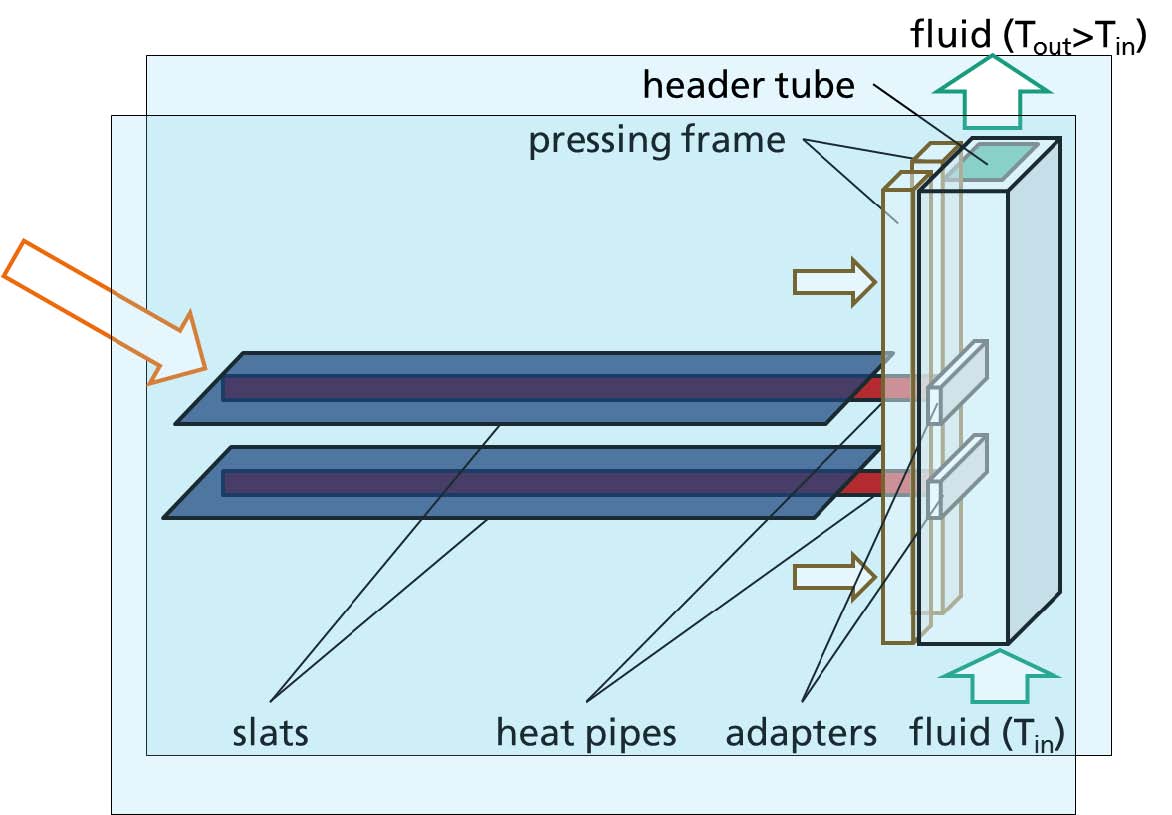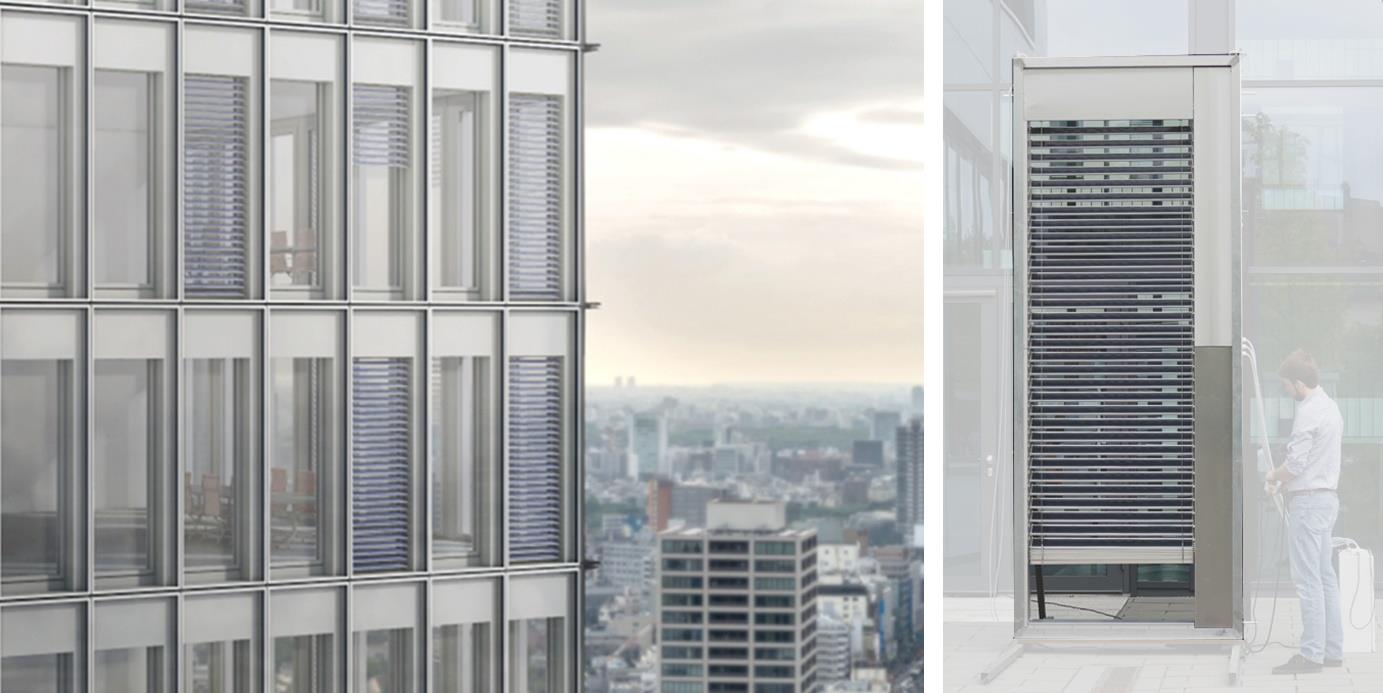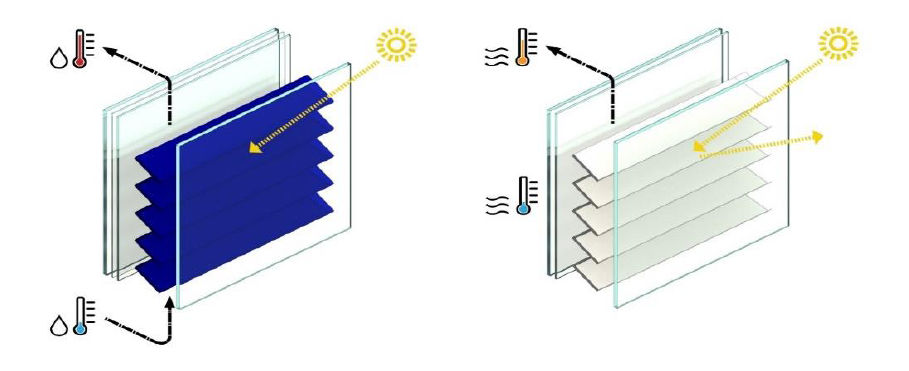Brief Concept Description
Solar thermal venetian blinds (STVB) represent a novel façade technology that combines solar heat harvesting, solar gains management and control of daylight and glare. As the solution is integrated in the form of venetian blinds, it is possible to meet different needs in varying weather conditions by simply changing the position of the curtain and the tilt angle of the slats, so to prevent glare or control the solar heat gains while maintaining the functionality of solar thermal collector (except for the case of fully retracted blinds).
The basic principle of the STVB system relies on the use of heat pipes integrated into each slat of the blind curtain, as shown in Figure 79. The top surface of the slat acts as absorber and converts the incident solar radiation into heat, which then transferred by the heat pipes to the header tube in a comparable manner as in evacuated tube collectors. A switchable thermal coupling is used to allow the heat transfer from the heat pipe condensers to the vertically aligned header tube while enabling the slats to be lifted and tilted as in a conventional venetian blind.
An adapter is placed around the heat pipe condensers to increase the heat transfer to the header tube. These adapters are pressed against the header tube by a frame which is moved by actuators such as springs and solenoids or camshafts. If the switchable thermal coupling is closed, i.e. the adapter is pressed against the header tube, the heat transfer from the slat to the header tube and the fluid within is efficient. On the contrary, the switchable thermal coupling can be opened to allow the movement of the slats. Each STVB has two hydraulic connections, that are the inlet and outlet pipe of the header tube used to connect with the building hydraulic loop.

Figure 79. Basic working principle of solar thermal venetian blinds with switchable thermal coupling consisting of pressing frame and adapters. © Fraunhofer ISE.
The STVB innovative solution is the result of an R&D project conducted by Priedemann Facade-Lab GmbH in collaboration with Fraunhofer ISE, IBK2 and University of Stuttgart in Germany.
Architectural and Technological Integration into the Envelope
The STVB can be placed within the cavity of a double skin façade (double skin, closed cavity façade or box-type window) between an outer single glazing layer and a double or triple glazing layer (see Figure 80). With this configuration, good solar thermal performance can be achieved, since the slats (i.e. the absorber of the solar collector) are insulated from the outdoor temperature via the outer single glazing layer. Moreover, the heat extraction from the façade has a high potential due to the high temperatures that can be reached within the cavity between the two glass layers and contributes to lower the solar energy transmission when required.
The façade systems that are the most suitable for the integration of STVB are pre-fabricated unitized façades. STVB can be adjusted in size and layout to meet the design of the façade and are then delivered as a plug-and-play components to the façade contractor for the integration in the façade element.

Figure 80. Visual impression of DSF with integrated STVB (left) © IBK2. Fully functional STVB within unitized façade system for testing (right) © Fraunhofer ISE.
Integration into the Building: System and Comfort
The system can be realized for high solar thermal performances, i.e. maximum thermal outcome, with the use of a selective coating on the slats and a highly insulated glazing on the interior, as shown in Figure 81. Alternatively, the STVB can better control the g-value lowering the heat income into the building when aluminium slats are used and less insulated glazing (double glazing) is installed as internal layer of the cavity.
Various control strategies can be adopted to control the venetian blinds. Ideally, an algorithm is used to optimize thermal and visual comfort as well as energy demand, including solar thermal energy gain, heating and cooling loads of the building and artificial lighting demand.

Figure 81. Use of STVB for high solar thermal performance (left) or low g-value (right). © Priedemann Facade-Lab.
Further Reading
R&D project website: www.arkol.de
Partner websites: www.priedemann.net / www.ise.fraunhofer.de / www.ibk.unistuttgart.de/ibk2
Haeringer, Simon & Denz, Paul-Rouven & Vongsingha, Puttakhun & Delgado, Alberto & Maurer, Christoph. (2019). ArKol - Development and Testing of Solar Thermal Venetian Blinds. PowerSkin Conference. Munich.
Denz, Paul-Rouven & Vongsingha, Puttakhun & Haeringer, Simon & Maurer, Christoph & Hermann, Michael & Morawietz, Katharina & Seifarth, Hannes. (2018). Solar thermal energy from opaque and semi-transparent façadescurrent results from R&D project ArKol. engineered transparency. Dusseldorf.